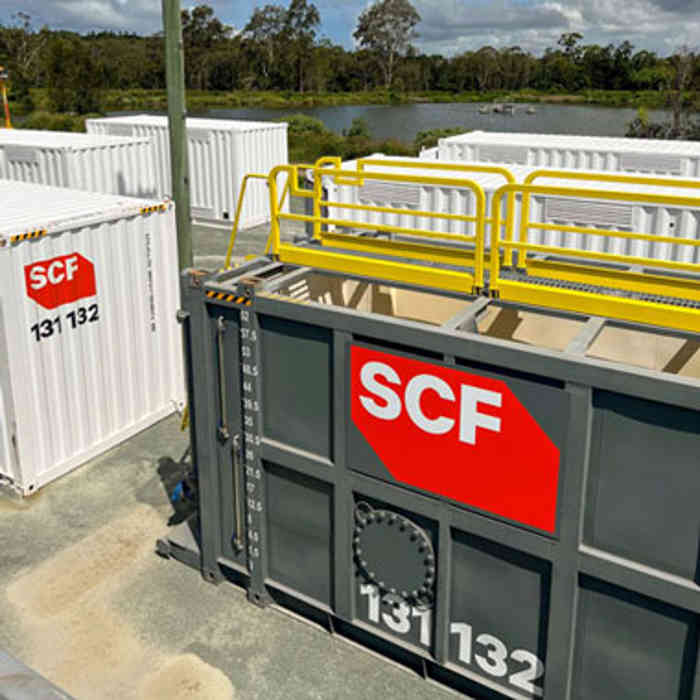Former Paper Mill
QLD
SCF’s expertise and range of tailored products saw Sarjaro engage them to provide tank and container services for the duration of the project.


Treat contamination on site in tanks that come with remediation specific features and take up less room than conventional options.
Environmental, water and waste remediation is as critical now as it has ever been. As society places greater importance on sustainability and the environment, remediation is critical in returning sites to their natural state.
As technology advances, so does the ability to undertake remediation on contaminated sites so water can be reused or returned to the natural environment, and soils, muds and sludge can be decontaminated.
Industrial sites are moving away from being contaminated, barren and desolate lots. They are being returned to their original environment, for new housing developments, public parks, reserves, or in one instance as a refuge for one of Australia's most loved animals, the koala.

One beneficiary of environmental remediation...
For close to 10 years, SCF has provided solutions for clients specialising in dewatering and environmental remediation.
From mining projects in rural Australia, to contaminated land from industrial operations and everything in between, a range of SCF products have been deployed to projects lasting from months to years. This includes Bulk Liquid Storage Tanks, ISO Liquid Tanks, Dangerous Goods Containers and standard 20ft or 40ft Containers.



Through ongoing development and innovation, a range of features to assist with the treatment process have been produced, such as baffles and weirs in tanks. This enables water to flow through the tank and drop solids out of suspension, which is critical for certain stages of water treatment.


SCF provides more than bulk liquid storage solutions. An industry leading range of Dangerous Goods Containers enable safe, certified storage of chemicals on site. These containers have also been modified on some jobs to house specialised equipment. We also provide a wide range of Site Sheds, for short or long-term projects.

Historically round poly tanks have been used on remediation sites due to their large storage capacity.
SCF Bulk Liquid Tanks provide a range of benefits for water remediation on site in comparison to options such as round poly tanks. These benefits include:
Space is often critical on environmental remediation sites.
Compared to alternative storage options, rectangular tanks can sustain the same volume of water storage and cover only half the surface area.
Their rectangular shape makes them easier to locate and lay out.
They are also stackable, which makes it possible to go up when it is impossible to go out.
Don't let tight space impact the storage volume on your site.


Bulk Liquid Tanks can be quickly, easily and cheaply transported on a standard truck.
No need for wide load over dimensional transport to get units to site.
Bulk Liquid Tanks can be placed on traditional semi trailers, or even rail to get them to metropolitan locations and beyond.
This significantly reduces the transport and deployment cost, whilst also reducing the speed of deployment.
Tanks can go from depot to your site within days.
Once on site, they can easily be moved or relocated too.
SCF Bulk Liquid Tanks are more than just storage devices.
They come with a range of specific internal and external features that are required to facilitate essential processes throughout environmental remediation.
Some remediation specific features include:
As a result, sediments can be separated during the water discharge stage.


Safety is critical in any industry. Like all containers in the fleet, SCF Bulk Liquid Tanks and ISO Tanks come with a range of safety features to make operation and deployment safer and easier.
Bulk Liquid Tanks come with AS1657 compliant inbuilt safety handrails that can be erected for safe operation from height. They also come with Sight Glass Level Gauges so users can externally see the current internal volume.
ISO Tanks come with the option of an integrated Breathe Easy valve, which displays a visual indicator when the Air Relief Valve is open. The Interlink System opens the Air Relief Valve when the Discharge Valve is engaged. These features are designed to reduce the operational steps, which has a flow on benefit for safety.
ISO Side Discharge Tanks are also used for liquid, however the discharge system is on the side of the tank. This enables the operator to discharge the tank from the ground, without having to work from height on top of the trailer.
Your storage volume requirements can change throughout the project, as a result of changing treatment volumes to significant weather events, such as rain or drought.
SCF Bulk Liquid Tanks can be connected in a farm configuration to increase storage capacity on site. Individual tanks can store 37,000 litres, up to 77,000 litres.
However connecting them into a farm configuration significantly increases this capacity anywhere up to and over 1 million litres.


With a range of purpose built tanks, remediation can take place on site.
Bulk Liquid Storage Tanks, Flowback Tanks with weirs and baffles, containers to house equipment and chemicals, and ISO Tanks for treated water storage prior to release, can facilitate all the necessary water treatment requirements.
No need to cart water offsite to be treated, saving you time and money.
The cost of a project can add up quickly considering some of the technical and large scale equipment that is used. Remediation projects can also vary in duration, from months to years. SCF tanks and containers can be hired for the duration of the project. This provides greater flexibility for your business, and reduces the initial upfront costs.
Remediation occurs on a site that is contaminated at the conclusion of a project, such as a mine or industrial zone, or prior to building or preparing a site that has been reclaimed for public use, such as a park, reserve or development. Returning the sites to their natural state via environmental remediation is required before new works can begin.
As more and more manufacturing moves offshore, disused manufacturing facilities are being rezoned for other uses. Depending on the age of such facilities and previous operations, a range of pollutants can be present which negatively impacts the soil and surrounding water (surface or groundwater).
Mining uses a range of chemicals and materials that can impact the surrounding environment. Commitment to environmental sustainability has increased to a level where the processes are less destructive on the environment. However there are still decommissioned sites that require remediation.
Decommissioned power and utility sites commonly require a level of remediation. A range of chemicals and contaminants that are required for power generation and ongoing maintenance can impact soil and waterways on these sites.
Contaminants can often be found in reclaimed landfill, such as ammonia, PFAS or methane gas. Reclaimed landfill is a common source of remediation. The breakdown of PFAS produces contaminated leachate, which is where remediation is required before a site is safe for public or environmental use again.
Defence have used and tested a range of materials that can impact the environment. Sites that are no longer used for defence purposes require remediation before they are suitable for use by the greater public.

Complete a form and one of our tank specialists will be in touch to discuss your requirements soon.
Prefer to speak with someone directly? Give us a call.